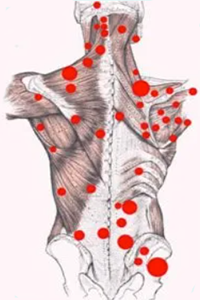Bodywork: Trigger Point Therapy, Part 1 (The Basics)
By Venice Sullivan, Ph.D., NCMT
 What exactly is a trigger point? Trigger points are areas of low neurological activity, that when stimulated or stressed, transform into an area of high neurological activity with referred sensation to other parts of the body. So what exactly does that mean? Think of it this way: when one area of the body is overloaded or stressed, it transfers or shares its load with some other part. The important thing to remember about trigger points is that they have no rules. This is why trigger points are not recognized by the American Medical Association, because they are not scientifically reproducible.
What exactly is a trigger point? Trigger points are areas of low neurological activity, that when stimulated or stressed, transform into an area of high neurological activity with referred sensation to other parts of the body. So what exactly does that mean? Think of it this way: when one area of the body is overloaded or stressed, it transfers or shares its load with some other part. The important thing to remember about trigger points is that they have no rules. This is why trigger points are not recognized by the American Medical Association, because they are not scientifically reproducible.
Trigger points (TPs) have the ability to transmit sensations from one muscle to another, such as a chest muscle to your forearm. They can also refer from one organ in the body to another organ, like your kidney to your liver. The combinations can be endless: from a gland to another gland, from a muscle to an organ, from an organ back to a muscle. TP’s may follow along muscle or nerve lines, or they may not. One well documented TP is found in the calf muscle that actually refers to the jaw. There are no clearly defined pathways from one to the other. One thing is for sure, everything is connected within the body system.
trigger points massage muscles neuromuscular
There are many books and charts written about researched and documented TPs. Then there are TPs that are based upon personal experience. Because each of us have different habits, postures and jobs; our bodies adapt to this stimulus in different ways. Another point that the world of medical science seems to forget is that: not all bodies are created equal. Anatomy books show us where a specific muscle begins and ends attaching on a specific spot on the bone. What we find in the bodywork world is there is a lot of disparity where those actual attachments are. Sometimes a muscle is completely missing, or only partially there. This will cause the body to function differently from the “norm”. Any medical professional working with you must understand that they are working with an individual, not a text book case. Finding the answer to the puzzle of your pain and dysfunction takes patience and knowledge.
From my personal experience, my body has taught me that when I eat specific foods, my stomach may not bother me, but my lower back will. Interesting. This would be a visceral (organ) to muscle trigger point. Many sources of our pain are far from obvious, and continued pain increases stress on our body, can raise our blood pressure, cause us to be overly tired, a lack of energy, brain fog, etc. One of the ways our therapists at HOPE Wellness Institute help resolve pain and the stress it causes is through Neurological Stress Reduction. This was partially discussed in the Low Level Light Therapy (LLLT) last week and will be discussed in more detail in upcoming newsletters.
Over the next couple of weeks, we will discuss in-depth on how to treat trigger points within the body utilizing Trigger Point Therapy and Neurological Stress Reduction, including ways in which you can self-manage your trigger points! If you have questions before then, please don’t hesitate to contact us.
